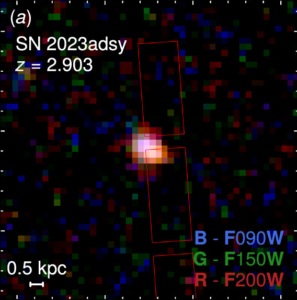Note: This article was originally published in Substack

A portion of the JADES Deep Field, produced by the JWST and released last month (June 2025) contains many supernovae that exploded when the universe was less than 2 billion years old. It includes the farthest supernova ever spectroscopically confirmed at a redshift of 3.6. Its progenitor star exploded when the universe was only 1.8 billion years old, a conclusion consistent with our prediction that no Type Ia supernovae will be found in galaxies with a redshift greater than or equal to 4. Image credit: NASA, ESA, CSA, STScI, JADES Collaboration
Using the JADES Deep Field, 2 new JWST studies just released confirm our prediction that no Type Ia supernovae will be found with a redshift (z) greater than or equal to 4. Type Ia supernovae occur when a white dwarf star (our sun will end up as one such star) accretes material from a companion star and explodes when the white dwarf reaches critical mass, referred to as the “Chandrasekhar” mass (named in honor of Subrahmanyan Chandrasekhar who derived its value in 1930 at the age of 19), of 1.44 Solar masses.
 From one of the new JWST studies, the following quote supports our conclusion. All objects in this study are referred to as “transients”, a term suggesting that they vary in brightness and require further study to determine their intrinsic nature. In this case, the light curves of the transient AT2023adsy, now identified as SN2023adsy, were spectroscopically confirmed by JWST to be a Type Ia supernova residing in a host galaxy whose redshift (z) is 2.903. Although there are other Type Ia candidates of interest, such as AT2022aevg, this one was the only one confirmed to be a Type Ia supernova.
From one of the new JWST studies, the following quote supports our conclusion. All objects in this study are referred to as “transients”, a term suggesting that they vary in brightness and require further study to determine their intrinsic nature. In this case, the light curves of the transient AT2023adsy, now identified as SN2023adsy, were spectroscopically confirmed by JWST to be a Type Ia supernova residing in a host galaxy whose redshift (z) is 2.903. Although there are other Type Ia candidates of interest, such as AT2022aevg, this one was the only one confirmed to be a Type Ia supernova.
We fit the light curve for AT2023adsy, which was spectroscopically confirmed as an SN Ia at z = 2.90 in host JADES-GS+53.13485-27.82088 with DDT Program 6541.
This is a groundbreaking result, as it is the highest-redshift spectroscopically confirmed SN Ia discovered thus far. Refer to J. D. R. Pierel et al. (2024c) for a complete analysis of AT2023adsy, who present the SN spectrum and photometric light-curve fitting and provide the first glimpse of SNe Ia as standard candles at z > 2.
ERO Program
The JWST Early Release Observing (ERO) program was a series of studies that began immediately following JWST’s commissioning in July 2022 that would highlight to the public and the world the power and potential of the new orbiting platform.
Excerpts
The JADES Deep Field, presented above, is one of the deepest, most comprehensive images to emerge since the JWST ERO program ended and is broadly used in new studies just published. The following includes excerpts from 2 papers recently published in the 3 years since JWST’s commissioning that support our prediction that no Type Ia supernovae will be found in host galaxies with a redshift ≥ 4.
NASA’s Webb Opens New Window on Supernova Science:
Peering deeply into the cosmos, NASA’s James Webb Space Telescope is giving scientists their first detailed glimpse of supernovae from a time when our universe was just a small fraction of its current age. A team using Webb data has identified 10 times more supernovae in the early universe than were previously known. A few of the newfound exploding stars are the most distant examples of their type, including those used to measure the universe’s expansion rate.
The JADES Transient Survey: Discovery and Classification of Supernovae in the JADES Deep Field:
The highest-redshift SN Ia discovered thus far is AT2023adsy at z = 2.90 (J. D. R. Pierel et al. 2024c), and we are unsure of the highest redshift at which SNe Ia exist (such
that the white dwarf progenitor has sufficient time to form). It is thus unclear how large of a risk the z > 3 SNe Ia pose to single epoch high-redshift galaxy surveys.Discovery of An Apparent Red, High-Velocity Type Ia Supernova at z = 2.9 with JWST:
Of particular interest to astrophysicists are Type Ia supernovae. These exploding stars are so predictably bright that they are used to measure far-off cosmic distances and help scientists to calculate the universe’s expansion rate. The team identified at least one Type Ia supernova at a redshift of 2.9. The light from this explosion began traveling to us 11.5 billion years ago when the universe was just 2.3 billion years old.
“High Redshift” Galaxies
To confirm our existing theories of the universe from the moment of the “Big Bang” to the present day, one of those studies, a study we described in detail, included imaging and spectroscopy of high redshift galaxies with a redshift greater than or equal to 6. That study looked at 4 specific, very high z galaxies.
Following the release of the initial ERO program studies and papers, conflicting stories emerged about how the JWST, rather than confirming the prevailing cosmological model, were upending it. These “conflicting stories” were premature, sensationalistic and largely inaccurate. We then published a response to them that included our assertion that no Type Ia supernovae will be found in galaxies whose redshift is greater than or equal to 4. To date, that prediction has held and is substantiated here with this excerpt from the same page that references SN2023adsy:
Of particular interest to astrophysicists are Type Ia supernovae. These exploding stars are so predictably bright that they are used to measure far-off cosmic distances and help scientists to calculate the universe’s expansion rate. The team identified at least one Type Ia supernova at a redshift of 2.9. The light from this explosion began traveling to us 11.5 billion years ago when the universe was just 2.3 billion years old.
Support for the Prevailing Cosmological Model
Our assertion supports conclusions of the prevailing model of the universe’s beginning and subsequent evolution. Using the evolution of 3–4 solar-mass stars, we constrain the redshift when Type Ia supernovae would first appear. This constraint corresponds to a “look-back time” of 12.5 billion years, a z of 4 or 1.3 billion years after the “Big Bang” and is consistent with the accepted timeline and beginning 13.8 billion years ago.
Among the surprises emerging from JWST’s initial investigations was that the universe evolved significantly faster than we previously thought.
To provide a little background, the accepted mathematical model of the Big Bang Theory of Cosmology, Lambda-CDM (Λ-CDM), has three major components:
Featured Image
3 galaxies from the first of ten studies published last month. Our prediction is that no Type Ia supernovae will be observed in galaxies with a redshift greater than or equal to 4. So far, that prediction has been borne out with the publication of the studies described above.
From the Jades Deep Field Transients page, characterizing JWST as a “Supernova Discovery Machine”:
a few of the newfound exploding stars are the most distant examples of their type, including those used to measure the universe’s expansion rate.
This mosaic displays three of about 80 transients, or objects of changing brightness, identified in data from the JADES (JWST Advanced Deep Extragalactic Survey) program. Most of the transients are the result of exploding stars or supernovae. By comparing images taken in 2022 and 2023, astronomers could locate supernovae that recently exploded (like the examples shown in the first two columns), or supernovae that had already exploded and whose light was fading away (third column).
The age of each supernova can be determined from its redshift (designated by ‘z’). The light of the most distant supernova, at a redshift of 3.8, originated when the universe was only 1.7 billion years old. A redshift of 2.845 corresponds to a time 2.3 billion years after the big bang. The closest example, at a redshift of 0.655, shows light that left its galaxy about 6 billion years ago, when the universe was just over half its current age.
From Las Cumbres Observatory, a quick, interactive web-based view of the sky at the moment, complete with interactive controls The Sky Now. The page includes “The Sky Tonight”, a quick, interactive web-based version of Stellarium.
Astronomy For Change: https://astronomyforchange.org
Did you enjoy this article or like what we do? Why not leave a tip or buy us a Coffee?
Follow Us On Twitter: https://twitter.com/astronomychange
Why not support us on Patreon: https://www.patreon.com/astronomyforchange
Imagination is more important than knowledge
![]()
An index of all articles can be found here.
If you enjoyed this article, please consider supporting us with a modest donation
![]()
or through a subscription on our Patreon Page
 Membership at Astronomy for Change is Free!
Membership at Astronomy for Change is Free!



